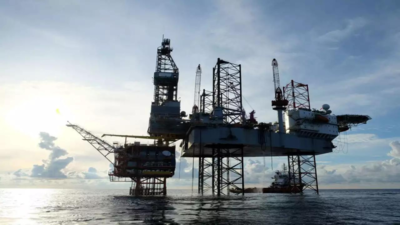- News
- World News
- US News
- Floating fortresses: US navy to convert oil rigs into mobile military bases
Trending
Floating fortresses: US navy to convert oil rigs into mobile military bases

(Representative image)
NEW DELHI: The US Navy has embarked on an innovative yet contentious project to transform surplus oil rigs into mobile missile defense and resupply bases in response to escalating missile threats in the Pacific, particularly from China. This initiative, developed by Gibbs & Cox, a Leidos company, was unveiled at the Sea Air Space 2024 expo in Washington DC.The Mobile Defense/Depot Platform (MODEP) concept is designed to convert oil platforms into large floating island bases that can operate independently for over 12 months, positioned at an ideal distance from shore.
The converted platforms will potentially play a dual role in enhancing US air defense capabilities or aiding in strike missions, with the capacity to hold up to 512 vertical launch system (VLS) cells or 100 large missile launchers. This capability is about five times that of an existing Arleigh Burke-class destroyer, according to Naval News.
Heruningtyas Desi Purnamasari, an official at the US Navy, outlined the strategic importance of these floating bases, noting, "The platforms could conceivably lead to a substantial reduction in risks and costs associated with land-based defense systems."
The concept also includes plans for these mobile platforms to support the sustainment of the US Navy’s surface combatants and nuclear submarines through an Afloat Forward Staging Base configuration, offering a cost-effective solution at only 10% of the price of a new build Ballistic Missile Defense (BMD) system.
More recently, Sam Tangredi of the Foreign Policy Research Institute highlighted the strategic advantages of sea bases, which include enhanced joint command capabilities and rapid strike potential. Tangredi also questioned whether new sea-basing technologies could keep pace with evolving anti-access/area-denial (A2/AD) threats, suggesting that while improvements in air and missile defenses might mitigate some risks, the practicality of investing heavily in sea bases remains uncertain.
This ambitious project reflects a shift in military strategy as the US adapts to new geopolitical realities and technological advancements in warfare, aiming to bridge the gap between sea and land-based BMD capabilities effectively.
The converted platforms will potentially play a dual role in enhancing US air defense capabilities or aiding in strike missions, with the capacity to hold up to 512 vertical launch system (VLS) cells or 100 large missile launchers. This capability is about five times that of an existing Arleigh Burke-class destroyer, according to Naval News.
Heruningtyas Desi Purnamasari, an official at the US Navy, outlined the strategic importance of these floating bases, noting, "The platforms could conceivably lead to a substantial reduction in risks and costs associated with land-based defense systems."
The concept also includes plans for these mobile platforms to support the sustainment of the US Navy’s surface combatants and nuclear submarines through an Afloat Forward Staging Base configuration, offering a cost-effective solution at only 10% of the price of a new build Ballistic Missile Defense (BMD) system.
However, the feasibility of such floating bases has been a topic of debate. In 2018, experts Jose Delgado and Eviya Vitola discussed the political and security challenges of creating semi-permanent offshore military bases, noting their high costs, vulnerability to missile attacks, and relative ineffectiveness compared to conventional capabilities.
More recently, Sam Tangredi of the Foreign Policy Research Institute highlighted the strategic advantages of sea bases, which include enhanced joint command capabilities and rapid strike potential. Tangredi also questioned whether new sea-basing technologies could keep pace with evolving anti-access/area-denial (A2/AD) threats, suggesting that while improvements in air and missile defenses might mitigate some risks, the practicality of investing heavily in sea bases remains uncertain.
This ambitious project reflects a shift in military strategy as the US adapts to new geopolitical realities and technological advancements in warfare, aiming to bridge the gap between sea and land-based BMD capabilities effectively.
End of Article
FOLLOW US ON SOCIAL MEDIA











